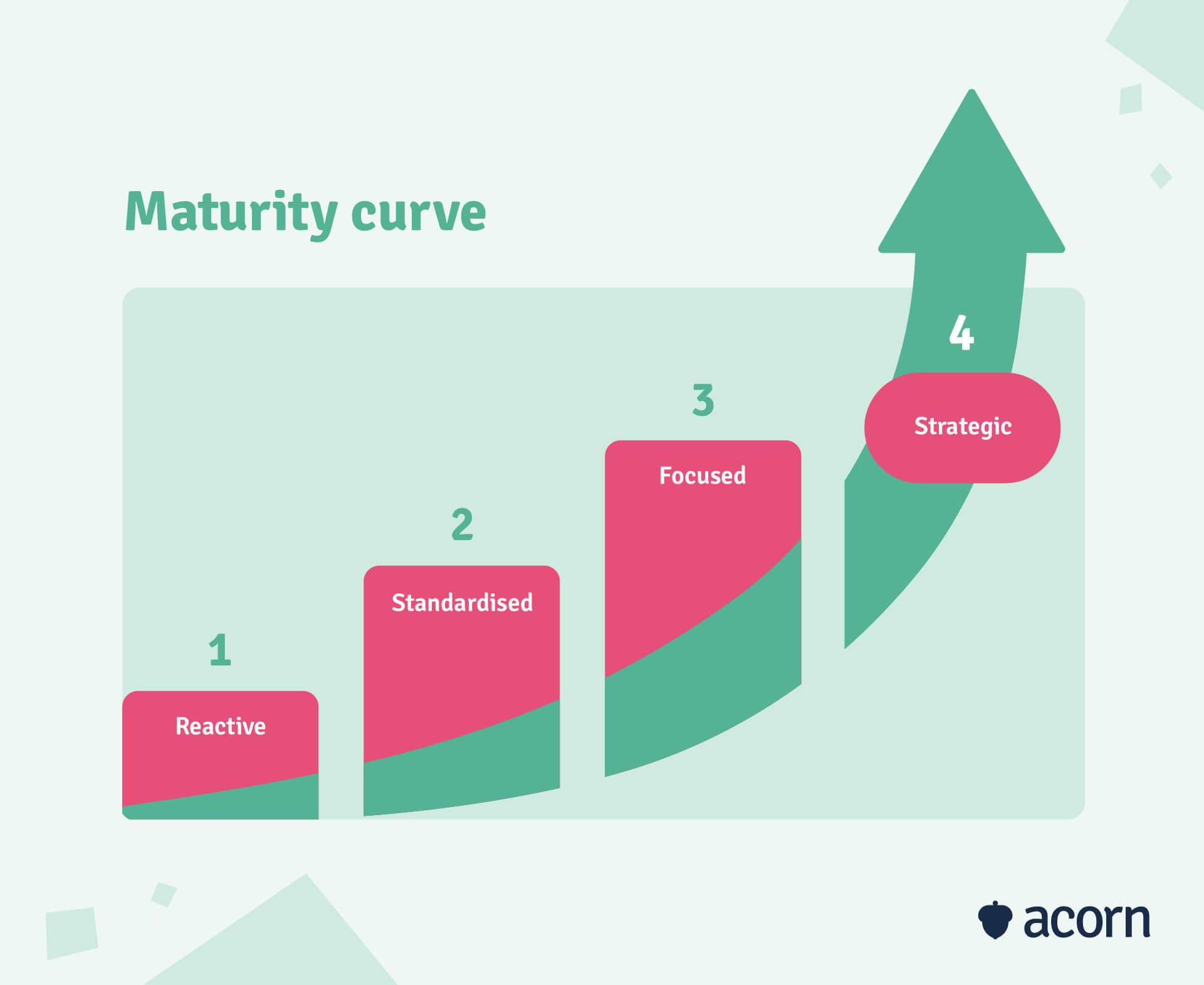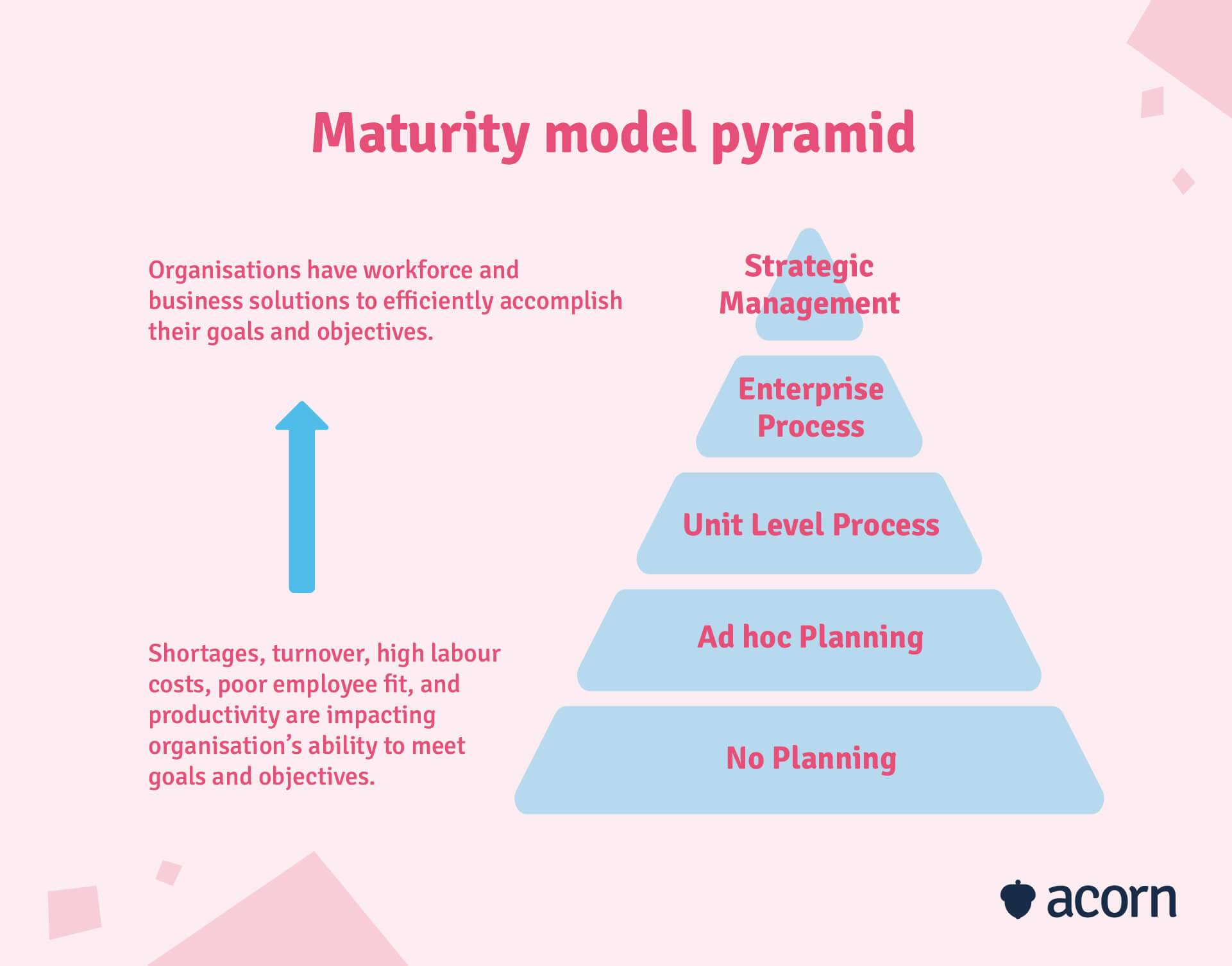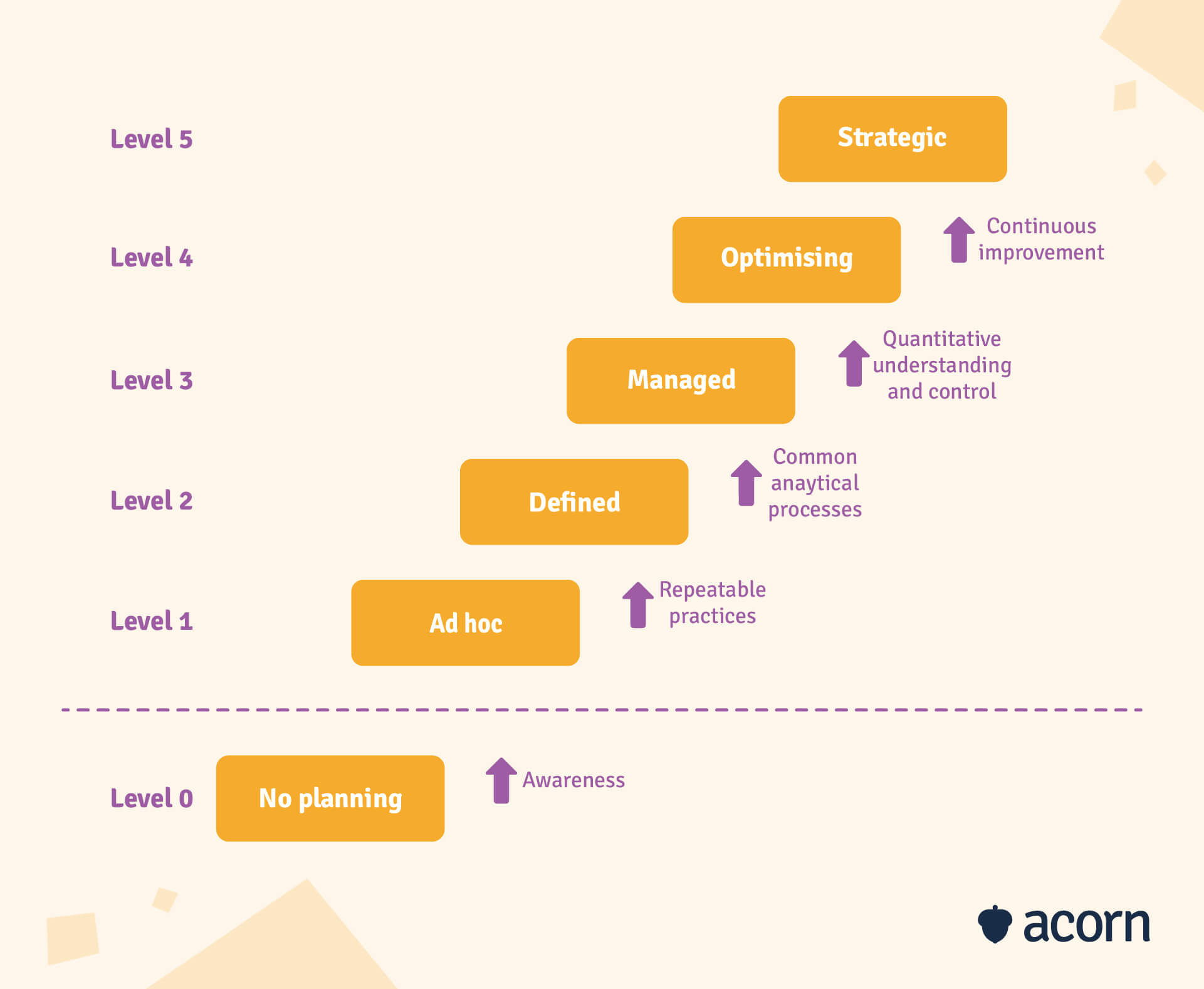Workforce Planning Maturity Model – The Data Driven Approach to Workforce Planning
Reading Time:

Lead the pack with the latest in strategic L&D every month— straight to your inbox.
SubscribeIn the quest to make your organisation future-ready with workforce planning, you may have stumbled across the workforce planning maturity model.
Workforce planning is all about getting the resources, talent and capabilities of your current workforce to align with your organisation’s strategy, which is why employers utilise workforce planning models to streamline the process and get the right people and skills in the right jobs at the right time. But workforce planning isn’t just about achieving objectives. It’s also about arming yourself with the knowledge and information to ensure your organisation is as efficient as it can be in a constantly changing environment. This is where maturity models come in.
So, let’s take a look at the workforce planning maturity model and how it actually works.
What is a workforce planning maturity model?
A workforce planning maturity model is a tool to help distinguish the maturity of your workforce planning practices. It helps assess the efficiency of your workforce and assists in identifying what skills and capabilities your business needs to improve. In other words, the maturity model is designed to guide your organisation in continuous workforce development.
What is workforce planning?
But first, what exactly is workforce planning? Workforce planning (WFP) is the process of preparing your workforce for the future by assessing what changes you need to make to your current workforce to make them ready for any predicted future scenarios. What new roles will be available in the future? What old roles will need to be refilled? What technologies, developments and improvements will change the landscape of the workforce?
It’s about taking time to identify and evaluate supply and demand, the gap between the two, and developing a plan to close that gap. In short, workforce planning is about aligning your workforce with your organisational goals and ensuring you get the right person with the right talent in the right job at the right time.
How are maturity models used for workforce planning?
So, how does workforce planning relate to maturity modelling? Well, as we mentioned before, the WFP maturity model is a means by which you can characterise the maturity of your organisation’s workforce planning activities.
It might surprise you to know that not every organisation utilises good workforce planning, and some don’t even utilise WFP at all. Applying WFP is an important step towards developing solutions for your workforce. The maturity model is simply a way to gauge the quality and effectiveness (or lack thereof) of the workforce planning processes you’ve implemented in your business. So, with this in mind it shouldn’t be much of a shock to learn that organisations that don’t involve workforce planning in their day-to-day aren’t as efficient in their ability as those that take time to develop strategic workforce plans with maturity modelling in mind.
It’s simple to apply once you understand it. The maturity model breaks down the different tasks associated with workforce planning into separate levels that we’ll go into more detail on later. Each level classifies certain workforce practices in terms of how “mature” they are, and therefore, how effective they make your business. Essentially, once you understand what each of the levels mean you’ll be able to place your business and its strategic actions on the model to determine how mature it really is.
Here at Acorn, we pioneered the first performance learning management system (PLMS) to help you in making that link between WFP tasks and business performance. A PLMS creates alignment between capabilities (the tools, processes, skills, knowledge and behaviours that combine to deliver on organisational objectives) and organisational strategy, demonstrating the real-world application of learning.
What does the workforce planning maturity model look like?
You might have heard of maturity models before, just under a different name. But they all do the same thing. A few different names for maturity models that you might have heard floating around are:
- Capability model
- Capability assessment
- Maturity assessment
- Maturity curve
These different types of maturity models all function in the same way, being split into the separate levels to categorise the maturity of your organisation’s WFP practices. But what does the WFP maturity model look like? Below are three examples of WFP maturity models that you can use to visualise where your business sits on the maturity scale.
The maturity curve model

The maturity model pyramid

The transition view maturity model

The various levels of a workforce planning maturity model
So how to you utilise the WFP maturity model? What are the different levels? Generally, maturity models are made up of five different levels, but the number tends to vary. Some versions of the maturity curve, for example, have only four levels. Other models even have levels ranging from zero. But if there’s one thing these maturity models can agree on, it’s what each stage actually represents. Let’s get into them below.
Level 1
The first level of the maturity model is known as the “no planning” or “reactive” level. It’s characterised by actions and decisions occurring as a reaction to problems or requests as they arise. Those problems could be anything from starting the recruitment process to identify new talent when an employee leaves the company to resolving an unexpected crisis. Because of the lack of workforce planning in these first-level organisations, they have no strategies already in place should issues like these occur.
In the end, the only major outcomes to come out of organisations that have no workforce planning are only immediate solutions with no ongoing strategic value.
The key takeaways from this stage of WFP maturity are:
- Decisions are only made in direct response to issues that arise.
- Results in short-term action plans.
- Decisions made are inherently operational due to their reactive nature.
Level 2
At the second level, the first hints of strategic workforce planning begin to appear. This level is often known as the “ad hoc” or “repeatable” level because organisations at this maturity usually only take time to develop workforce plans sporadically or as a one-off.
Extensive effort goes into gathering data and obtaining information, and it helps to inform the creation of short-term strategic plans. Usually, WFP at this level is limited to one or two departments, but sometimes covers the whole organisation superficially.
The key takeaways from reactive level WFP are:
- WFP occurs irregularly.
- Collecting data requires substantial manual effort.
- WFP is limited within the business.
Level 3
This stage is often called “standardised” or “defined”. This is where strategic workforce planning really begins. At this level, the organisation works to gather information and consistently and regularly report on data. That data and information can be shared with the related collaborators such as HR management and executives.
This is just what you want, right? Implementing workforce planning into your business? Well, not quite. While businesses at this level have started to utilise WFP, they don’t tend to bother with many insights into historical data, scenario planning, or modelling. They also tend to keep relying on manual efforts to collect information and store it.
The key takeaways from standardised workforce planning maturity are:
- Dedicated reports are established to summarise information and data.
- WFP is usually utilised only once per year.
- Analysis of historical data is not yet conducted to understand trends.
Level 4
The “focused” or “managed” level is where the strategic workforce planning process begins to evolve. At this level, the organisation shifts its focus to aligning HR with business strategy and goals. This means that the business has moved to an automated integration of data, allowing resources to move on to focus on more valuable workforce challenges.
Here, organisational planning begins to inform decisions about the future based on applying gained insight on past trends. Any workforce plans that are decided on are also regularly re-evaluated and adjusted to keep up with the constantly changing internal and external environment. An organisation at the focused level is just a little bit more “mature” than most.
The key takeaways from focused workforce planning maturity are:
- Workforce plans are reviewed regularly.
- Planning is driven by analysis into trends and business goals.
- HR is aligned with business strategy and goals.
Level 5
Finally, the top level of maturity is often known as “strategic” or “optimising”. Few organisations actually improve themselves enough to make it this far up the maturity curve, because to get here, an organisation needs to have a data-driven and data-based mindset in order to meet business outcomes.
Strategic organisations know exactly what approach and skills they need to achieve future desired outcomes. Analysis of data is used to understand what has happened in the past, and why it happened that way. Planning is used to evaluate what needs to change, and how. With improved analysis and planning, your organisation will find it has also improved outcomes such as engagement, turnover and recruitment, and being able to retain employees.
The key takeaways from strategic level workforce planning maturity are:
- Predictive analysis is available to all.
- Analysis and planning increases HR outcomes.
- Data is connected to make predictions and analysis more efficient.
Why a workforce planning maturity model is important
So now you know the different levels of the WFP maturity model and how it categorises organisational maturity. But you’re probably wondering how important it really is, and what the benefits are to your business. Let’s dive in.
- Reliability: Mature-level organisations have more efficient management and implementation in place. An efficient automated process means time and focus can be shifted to address other challenges and allows for more consistent delivery.
- Cost-effective: The more mature your organisation is, the more cost-effective it will be as you’ll have a clearer line of sight on your workforce planning needs and the agility to address them sooner, thus saving on costs. Your effective management and implementation will also save your organisation costs in fixes and re-works.
- Competitive: Better processes means your organisation can be more efficient by improving the quality your current organisational performance. You’ll be more competitive, able to get ahead of competing organisations, and remain ahead of the game.
- Process improvement: Understanding the level of maturity your workforce planning activities are up to, and standardising them, will ensure that your best workforce practices are defined and adopted within your organisation. It will allow for a level of automation that will provide the organisation with the support to continue running without losing knowledge of those activities due to things such as turnover.
Key takeaways
WFP maturity models are the most efficient way to ensure that your strategic workforce planning practices are helping to improve your organisation in the best way they can, and that they remain on an upward trajectory, all whilst also being benchmarked against best in class.
By implementing a maturity model, you will enhance your business’s performance and processes, and reduce the amount of effort in terms of budgeting and labour required to deliver on outcomes by continually improving on your workforce planning practices. Not only will it assist you in contextualising your business processes in terms of maturity, but it can also identify what improvements you need to reach the next level of organisational maturity.